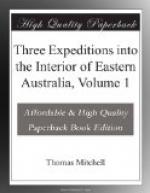Ride to Greenough’s group.
View from the summit.
Barter with natives beyond the Darling.
The Red tribe again.
New species of caper eaten by the natives.
Importunity of the Red tribe.
Cross the Darling.
View from the summit of Mount Macpherson.
Rain again threatens.
Absence of kangaroos and emus on the Darling.
The Occa tribe again.
Hints to Australian sportsmen.
Meet the Fort Bourke tribe.
Mr. Hume’s tree.
Return to Fort Bourke.
Description of that position.
Saltness of the Darling.
The plains.
The rivers supported by springs.
Traces of floods.
Extent of the basin of this river.
Its breadth.
Surface of the plains.
Geology of the Darling.
Woods.
Gum acacia abundant.
Grasses.
General character of the natives.
Their means of existence.
Nets used by them.
Superstitions.
Condition of the females.
Singular habits of a rat.
Security of a species of ants.
Birds.
Fishes.
Apprehended scarcity of water on leaving the Darling.
Six of the cattle dead from exhaustion.
Rest of two days at Fort Bourke.
Visited by the Fort Bourke tribe.
COMMENCEMENT OF THE HOMEWARD JOURNEY.
July 12.
Early this morning ten men returned to the river with orders to raise the bullock to the bank, but after they had done so it again lay down, unable to move, the legs having become probably cramped or benumbed from remaining so long fast in the mud. They then descended the river about two miles to where the other bullock lay, which they were equally unable to move. No natives appeared or were even heard; and thus we might be considered to occupy the left bank of the river, all along our front. We broke up the camp at ten A.M. and turned our faces homewards. Our old track was a tolerably well beaten road, and therefore much easier for the bullocks, especially those of the leading cart; it was also no longer necessary to face bush or scrub. To me the relief in travelling homewards was considerable, as I was much more at liberty to attend to arrangements necessary for our defence than when the direction of our route required my attention. This day we cut off a corner by which we shortened our way about a mile; and we reached our second encampment back from that which we left in the morning, thus effecting two days’ journey in one.
THE CATTLE BEGIN TO FAIL.
We only got to our ground however by eight o’clock at night; and before we arrived one bullock, which had been some time weakly, lay down to rise no more, and we were compelled to shoot it. The camp we reached was near the large native village on the river, and the hill with the natives’ tombs (see July 8) and the same spot where the gin and the tall man first came up to us. We approached the place with some caution but found nobody in occupation, and we encamped with a strong guard on our cattle.




